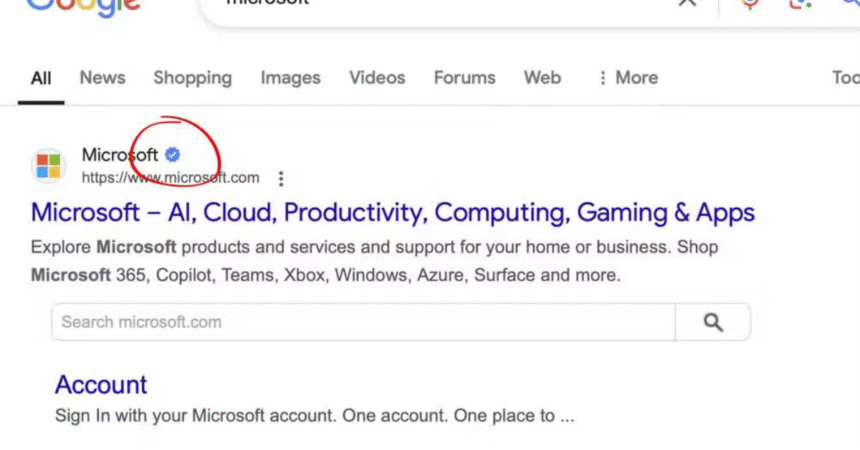In a world increasingly dominated by digital interactions, trust and authenticity are becoming paramount for both consumers and businesses alike. As users navigate through vast amounts of information available on the internet, distinguishing reliable sources from misleading ones is crucial. In response to this challenge, Google is testing a new feature that could significantly change how users perceive business links in search results: blue checkmarks indicating verified businesses. This initiative not only reflects the growing demand for authenticity but also aims to address the prevalent issue of spam and misinformation that has plagued online searches for years.
The Emergence of Verification Symbols
The concept of verification symbols is not new; social media platforms like Twitter (now X) and Instagram have long used blue checkmarks to denote verified accounts. Originally designed to confirm the authenticity of public figures, brands, and organizations, these symbols have come to symbolize trustworthiness in an otherwise chaotic online environment.
With the rise of misinformation and the increasing sophistication of scams and spam, Google’s move to implement a similar system in its search engine is a natural evolution. By allowing users to easily identify verified businesses, Google is taking steps to enhance user confidence in the information they find. The goal is straightforward: to create a safer online environment where consumers feel secure engaging with brands and making purchasing decisions.
How the Blue Checkmarks Work
Currently in the testing phase, the blue checkmarks will appear alongside verified business links in Google search results. Users who have been selected for the trial will notice these symbols, which serve as a visual confirmation of a business’s legitimacy. The feature is intended to make it easier for users to trust the links they click on, potentially improving click-through rates for verified businesses.
The process for verification is expected to involve businesses meeting certain criteria established by Google. This could include providing documentation to prove their legitimacy, such as business licenses or tax information. While specifics are still under wraps, businesses that achieve verification will likely benefit from increased visibility and credibility.
Addressing the Spam Problem
The introduction of blue checkmarks is particularly timely, given the ongoing concerns about spam and fraudulent content in search results. The digital landscape is rife with misleading websites and ads, making it increasingly difficult for users to navigate safely. Many people have experienced clicking on what they thought was a legitimate link, only to find themselves on a suspicious or fraudulent site.
Google’s initiative aims to combat this issue directly. By verifying businesses, Google is not just enhancing user trust but also improving the overall quality of search results. Verified links are likely to rank higher in searches, encouraging businesses to adhere to higher standards. In an environment where trust is a currency, this could level the playing field for smaller businesses that prioritize authenticity.
Google’s Cautionary Disclaimer
Despite the promise of enhanced user trust, Google has also issued a cautionary disclaimer regarding the blue checkmarks. The company has clarified that while a blue checkmark indicates that a business has been verified, it does not guarantee the reliability of that business or its offerings. This is a crucial distinction for users to understand, as verification does not equate to an endorsement or assurance of quality.
Molly Shaheen, Google’s spokesperson for public affairs, emphasized this point, noting that the feature is still in its testing phase. “As mentioned earlier, this feature is only in its testing phase for now, so you won’t be able to see it just yet,” she stated. This transparency highlights Google’s cautious approach to rolling out new features, ensuring that users have realistic expectations.
Implications for Businesses
The introduction of blue checkmarks could have profound implications for businesses of all sizes. For companies that achieve verification, the blue checkmark could serve as a powerful marketing tool. It may enhance their credibility and attract more customers, as users will likely prefer to engage with verified businesses over unverified ones.
For smaller businesses, obtaining verification might provide a significant competitive advantage. In a market often dominated by larger corporations with established brands, verification could offer smaller entities a chance to shine. By signaling their legitimacy, these businesses may attract a more extensive customer base, increasing their visibility in search results.
However, the verification process itself may present challenges. Businesses will need to navigate Google’s requirements, which may vary based on industry or location. While the process is designed to ensure authenticity, it could also create barriers for some businesses that may not have the resources to meet verification standards.
User Experience and Trust
From a user experience perspective, the addition of blue checkmarks aligns with broader trends in digital consumption. Consumers are becoming increasingly discerning about the information they encounter online, and trust has become a critical factor in their decision-making processes. The visual confirmation of a business’s authenticity could lead to higher engagement rates, as users may feel more confident clicking on verified links.
Moreover, the implementation of such features may serve to improve the overall search experience. Users are more likely to feel secure browsing through search results when they can easily identify verified businesses. This could lead to increased user satisfaction and loyalty, as people appreciate platforms that prioritize their safety and provide reliable information.
The Future of Online Verification
As Google continues to test this feature, its long-term impact on the broader online ecosystem remains to be seen. If successful, the introduction of blue checkmarks could establish a new standard for verification across search engines. Other platforms may feel pressured to adopt similar systems, recognizing the importance of trust and authenticity in the digital space.
Moreover, this trend toward verification could lead to the development of new tools and technologies designed to enhance online credibility. As the demand for trustworthy information grows, businesses may increasingly invest in measures to prove their legitimacy, leading to a shift in how companies interact with consumers online.
The Role of Education and Awareness
While the introduction of blue checkmarks is a step in the right direction, it is essential for users to remain informed and vigilant. Verification does not eliminate the risks associated with online interactions, and users must continue to exercise caution when navigating the digital landscape.
Education about what verification means and how to interpret blue checkmarks will be crucial for users. Understanding that a checkmark indicates legitimacy but not necessarily quality will help consumers make informed decisions. Google may also play a role in educating users about this feature, ensuring that they know how to leverage it effectively.
The introduction of blue checkmarks next to verified business links in Google search results represents a significant advancement in the ongoing effort to enhance trust and authenticity in online interactions. As users increasingly demand reliable information, Google’s initiative could reshape how businesses present themselves online and how consumers engage with them.
While the testing phase is still ongoing, the potential implications for businesses and users alike are profound. Verified links could lead to improved user experiences, increased engagement, and enhanced trust in digital interactions. As Google continues to refine this feature, the digital landscape may be on the brink of a new era of online verification.
Ultimately, as the feature rolls out to a broader audience, it will be essential for users to remain informed and engaged. Understanding the significance of blue checkmarks, alongside exercising caution in their online behaviors, will empower users to navigate the digital world more safely and confidently. The future of online verification is unfolding, and it promises to create a more trustworthy internet experience for all.
#Google #Verification #OnlineTrust #SearchResults #DigitalSafety #BusinessCredibility #Misinformation #TechNews







